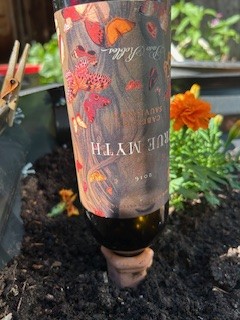Anne Gehrig
OSU Hood River County Extension Central Gorge Master Gardener Volunteer
Here in the PNW we live in a paradise of hydrologic abundance. Surrounded by lakes, rivers, waterfalls, and snowy peaks, it’s easy to take water for granted. When the rainy days of “Junuary” finally give way to July, we turn on the tap to keep gardens growing and lawns lush. But changing climate patterns and watering restrictions serve as reminders that we all need to practice mindful water use. We can’t control the weather, but we can use wise watering practices to keep our gardens healthy no matter what Mother Nature may throw at us.
When water resources are short, brown is the new green–at least for lawns, which can survive long periods of dry weather and will green up when rains return. But fruits and vegetables are 75-90% water and require regular irrigation to survive. Water-stressed plants can take weeks to recover, and inconsistent watering can interfere with fruit development or quality, as anyone who’s experienced bitter cucumbers or blossom end rot knows.
Duration, timing, and technique are the keys to optimizing irrigation in the vegetable garden. Deep, infrequent watering encourages plants to develop strong root systems that reach deep into the soil for water and nutrients, resulting in plants that are more resistant to the effects of hot, dry weather. A common rule of thumb for vegetable gardens is an inch a week, but that amount can dissipate quickly in hot, windy weather. Many experts advise saturating the soil to a depth of 6-8 inches to allow plants time to access the water they need. Watering early in the day is another way to minimize water lost to evaporation.
Sprinklers, soaker hoses, or drip? With so many options it can be challenging to find the method that’s ideal for your garden. Factors to consider include your site, soil texture, and available resources. Overhead sprinklers mimic the action of rain, delivering water over a large area– including places where it’s not needed, like sidewalks and driveways. They also deliver water mainly to the foliage, where it is of little benefit to the plants. Here in the Pacific Northwest, overhead watering can contribute to the spread of fungal and bacterial diseases. Drip systems and soaker hoses minimize evaporation and allow soil to slowly absorb water, directing it to where it is most needed: the plant’s root zone. A potential downside is that rodents and equipment can damage tubing and emitters, making regular monitoring and maintenance a must.
Gardeners without access to irrigation water might want to try a less familiar option: terracotta watering spikes. This low-tech, low-cost method is an adaptation of the ancient practice of burying water-filled clay pots in the soil. Ollas, or clay pots, are still used in many parts of the world where water is scarce and modern irrigation systems are costly. It’s simple to implement: bury the spikes near thirsty plants and insert inverted bottles of water into the opening. Over the last several years, twenty dollars’ worth of spikes and a dozen responsibly-emptied wine bottles helped my vegetables and container plants survive, even when temperatures soared into the upper 90’s. The next time you enjoy a cool beverage on a hot summer day, consider sharing a bottle with your plants. Learn more about clay pot irrigation here: Irrigating with Ancient Ollas.
Bare soil is an easy mark for weeds, erosion and evaporation, but mulching can keep the soil moist and weeds at bay. A 2- to 4- inch application of mulch suppresses weeds, reduces erosion, and moderates fluctuating soil temperatures. Almost any natural or synthetic material can be used as mulch, but organic mulches like straw, untreated grass clippings, and leaves offer the added bonus of breaking down over time, feeding earthworms and microbes and enabling the soil to better absorb and retain water. More information on how to mulch can be found in this OSU Extension Master Gardener publication: Gardening with Mulches
Like mulches, Intensive beds shade the soil and minimize weeds. In this method, plants are spaced close enough that their canopies barely touch when fully grown. Seeds of fast-growing, shade-tolerant plants like spinach and radishes can be sown in the empty spaces beneath peppers, tomatoes, and other large plants. The taller plants shade the seedlings, and by the time the older plants have reached their full size, the smaller ones will be ready for harvest. A densely-planted garden produces an abundant harvest with reduced water consumption.
Temperatures and irrigation costs may be on the rise and droughts may become longer and more common, but by implementing mindful watering practices, we can all contribute to a healthier, more sustainable water future.
Central Gorge Master Gardener volunteers provide free beginning gardening classes and continuing education to home gardeners. For research-based information about specific gardening or pest questions, submit your concern online at extension.oregonstate.edu/mg/hoodriver or by phone at 541-386-3343. Home gardeners can also drop off plant or pest samples Monday – Thursday between 9 AM and 4 PM at the OSU Hood River County Extension Service, 2990 Experiment Station Drive, Hood River, OR.
The Central Gorge Master Gardener program is a division of the OSU Hood River County Extension Service. OSU Extension Service prohibits discrimination in all its programs, services, activities, and materials.


Leave a Reply